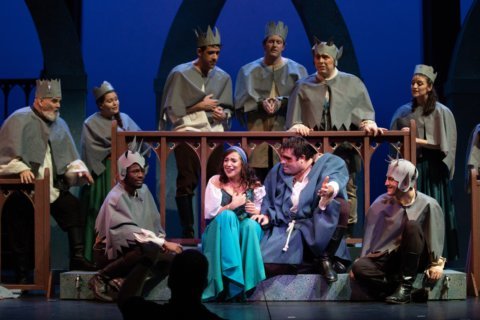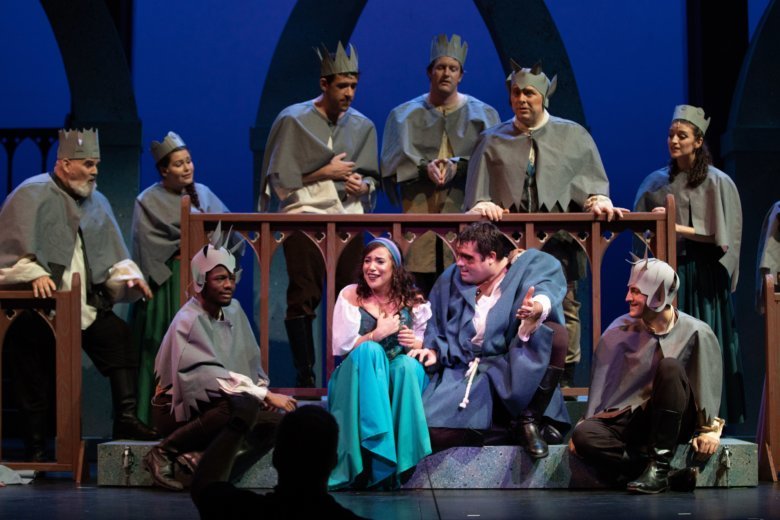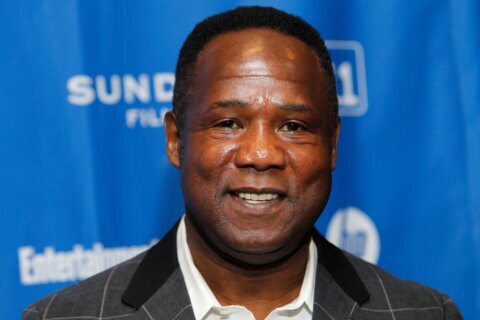WASHINGTON — Great theater transcends all boundaries — even the spoken language.

That’s the case with the Arlington Players’ unique new production of “The Hunchback of Notre Dame,” which stars Alex Bryce, who, like his iconic character Quasimodo, happens to be deaf.
“It’s just been an incredible opportunity,” Bryce told WTOP. “I never thought I could have an opportunity like this. It’s exciting beyond belief. … It’s just been a great learning experience (and) I’m looking forward to seeing how the audience reacts to my version of Quasimodo.”
Adapted by playwright Peter Parnell from the 1831 novel by Victor Hugo, the story follows deformed Paris recluse Quasimodo (Bryce), whose controlling uncle Frollo (Adam Strube) keeps him isolated in the bell towers of Notre Dame Cathedral. One day, Quasimodo decides to explore the outside world, falling for the beautiful gypsy Esmeralda (Adelina Mitchell).
“Quasimodo really grows up in isolation, disconnected from the world,” Bryce said. “He meets a girl named Esmeralda, falls in love with her and of course there are two other men who fall in love with Esmeralda as well. So, you have a lot of dramatic tension in that love triangle. You also have the storyline of Quasimodo trying to figure out who he is, in and of himself and in relation to other people, because he has been in this forced isolation up until this point.”
The original story elements actually make perfect sense for a deaf actor in the role.
“The original Quasimodo from the book has been made deaf by the ringing of the bells,” director Rich Farella told WTOP. “We had the opportunity to cast a deaf actor in a deaf role.”
How exactly does the sign language work on stage?
“We still have someone singing his voice … who gets to sing all the beautiful numbers and speak occasionally when Quasi’s inner monologue is being displayed,” Farella said. “Every performance will be exactly the same from Alex’s perspective. Alex will be on stage for every performance. He will be signing the show whenever Quasi’s line is spoken.”
In addition, there will be a special night on Oct. 13 specifically for deaf audiences.
“We’ll have a specific performance, where off the stage will be standing an interpreter to interpret all of the additional lines in the show,” Farella said. “All of the lines that are spoken will be interpreted for one night, so that the deaf community has an opportunity to see this show and to see a musical where they otherwise might not be able to follow what’s going on.”
The show will feature the Oscar-nominated Disney songbook of Alan Menken (music) and Stephen Schwartz (lyrics), including such memorable songs as “Topsy Turvy” and “Out There.”
“That was one of my favorite songs growing up — and not a small reason why I wanted to do this show,” Farella said of “Out There,” which features lyrics extra fitting for this production:
“All my life I wonder how it feels to pass a day, not above them, but part of them. And out there, living in the sun, Give me one day out there, all I ask is one. To hold forever, out there! Where they all live unaware. What I’d give, what I’d dare, just to live one day out there!”
These songs unfold against period sets by Dan Widerski and costumes by Joan Lawrence.
“Joan has designed some beautiful costumes,” Farella said. “He will have a hunch and makeup, but we want to show the humanity in Quasi, so we’re not going to do a full prosthetic. We want the audience to understand that even though he is different, he is just like them.”
How does Bryce perform the hunched body language made famous by Charles Laughton?
“It was a really big challenge trying to practice with a hunch and naturally shape my body to look like it has a hunch,” Bryce said. “I’ve been mostly successful with as little pains as I can manage, but it is tough because I’m a larger guy. The man who plays Frollo is smaller in stature, so it’s just a lot of interesting physical contrast. … Being physically hunched over, my shoulders are crooked, I might favor one arm. … So I’ll have a shorter range with my left arm.”
How does he enjoy his onstage chemistry with Mitchell’s Esmeralda?
“The two of us have a few scenes together,” Bryce said. “There’s a really good natural energy, an openness. It’s very easy for the two of us to work together and have those dialogues when we’re in character. I feel like Quasimodo really connects with her character Esmeralda, the warmth and energy that she has, and that allows for the connection to happen. … At the end, I actually teach her to sign. She agreed it was really important to have that human connection.”
For Bryce, it’s a moment of personal triumph in his second ever role.
“I was involved in a deaf theater world in college,” Bryce said. “It was really great to see that deaf people can be involved on a community theater stage [like Arlington Players]. I had been involved backstage, helping with the painting and building of sets, but you really don’t have a lot of opportunities to see where deaf people can be involved. … When you bring in a deaf actor, it gives a different spin and perspective on the stories you might already know.”
We may know the story, but I have a hunch this rendition will give audiences goose bumps.
Find more details on the theater website. Hear our full conversation with the cast and crew below:









